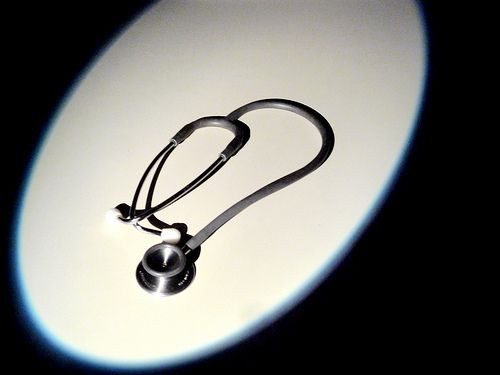Doctors’ Stethoscopes Are Dirtier Than The Palms Of Their Hands: How Clean Is Clean Enough?

The last decade or so has seen a revolution in the way physicians and nurses approach cleanliness in hospitals. Gone are the days of doctors smoking cigarettes bedside. Now even entering a hospital room requires a well-lathered glob of Purell to be rubbed through personnel’s hands. But a new study has found a rogue source of contamination: doctors’ stethoscopes.
Many doctors consider their stethoscopes to be like their third arm, a part of them as much as any other limb. As researchers from the University of Geneva Hospitals have found, however, these honorary appendages weren’t being given the same care as their natural ones. Neglecting to sanitize the stethoscope could help aid in disease transmission in the same way a lack of hand washing does, the team argued.
"By considering that stethoscopes are used repeatedly over the course of a day, come directly into contact with patients' skin, and may harbor several thousands of bacteria (including MRSA) collected during a previous physical examination, we consider them as potentially significant vectors of transmission," commented lead investigator Dr. Didier Pittet, director of the Infection Control Program and co-researcher, in a statement.
Pittet and his colleagues collected data on 71 patients who received examinations from one of three doctors, all of whom wore sterile gloves and used sterile stethoscopes. The team then swabbed those stethoscopes — on both the tube and the diaphragm (the disk used for hearing) — along with the doctors’ fingers and hands to collect bacteria samples.
Overall, the doctors’ fingertips were the only location dirtier than the stethoscopes. All other areas, including the backs of their hands, their palms, and residue on the fleshy outer muscles of the palm — known as the hypothenar eminence — showed less contamination than the instrument. The stethoscope’s tube also showed more contamination than the backs of doctors’ hands.
Pittet told ABC News that ultimately the problem comes down to effective educational measures. "There are guidelines when and how to clean hands," he said, but "there are no guidelines telling you when and how to clean stethoscopes."
Other infectious disease experts caution patients not to read too much into the study, however, as one of the main bacteria analyzed was for methicillin-resistant Staphylococcus aureus, better known as MRSA. "The problem is that it is not clear that this is an important cause of infections with MRSA and does not put it into perspective with the multiple other MRSA sources in and outside the medical environment,” Dr. John Bartlett, former chief of infectious diseases at Johns Hopkins, told ABC News. At the same time, any increase in exposure is poised to raise patients’ risk.
Ultimately, patient responsibility may enter the equation, too. Doctors are no doubt responsible for keeping their hands and medical equipment clean, but patients should feel compelled to act as an honest broker to ensure these measures are taken. "It is a perfectly reasonable thing to inquire about," Dr. William Schaffner, an infectious disease specialist at Vanderbilt University, told ABC. If they’ve taken the proper precautions, doctors should simply "smile and say, 'Yes, we've done that.'"
Source: Longtin Y, Schneider A, Tschopp C, et al. Contamination of Stethoscopes and Physicians' Hands After a Physical Examination. Mayo Clinic Proceedings. 2014.
Published by Medicaldaily.com



























